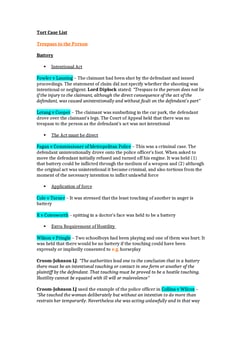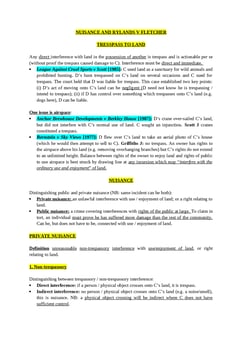Revill v Newbery [1996] 1 All ER 291
Judgement for the case Revill v Newbery
Table Of Contents
KEY POINTS
Understanding and managing liabilities is crucial in legal matters, as it involves identifying legal responsibilities and obligations that individuals or entities may have towards others, ensuring compliance with applicable laws and regulations.
Personal injury cases revolve around harm caused to an individual due to another party's negligence or intentional actions. Key aspects include determining liability, assessing damages, and seeking compensation for the injured party.
Legal actions often intersect with the public interest, requiring a consideration of the broader community's welfare and well-being. Balancing individual rights with public interests is a fundamental aspect of legal decision-making.
Self-defense is a legal concept that permits individuals to protect themselves or others from imminent physical harm. It involves assessing the reasonable use of force in response to a perceived threat and understanding the legal limits of such actions.
Trespass to land concerns unauthorized entry onto another person's property. Understanding the legal boundaries and consequences of trespassing is essential, as it can lead to civil lawsuits and potential criminal charges.
FACTS
The case involves an appeal (by Newbery (N)) against a damages award in a personal injury lawsuit initiated by Revill (R). R suffered a close-range gunshot wound inflicted by N when R trespassed onto N's allotment. N had been asleep inside his shed when he was awakened by R's attempt to break in.mIn response to the intrusion, N inserted his shotgun through a hole in the shed door and discharged it.
The judge determined that N had used violence beyond what was reasonably allowed for lawful self-defence. The judge also found N negligent, judging his actions against the standard of care expected of a reasonable person facing a similar situation.
N challenged the negligence finding and argued for a complete defence based on the principle that no legal claim could arise from an illegal or immoral act.
JUDGEMENT
The appeal made by N against the damages award was dismissed. The finding of negligence by the lower court was thoroughly examined and found to be substantiated by the facts presented.
Regarding the application of the doctrine of ex turpi causa non oritur actio, it was acknowledged that a public interest imperative prevented individuals engaged in illegal conduct from benefiting from their crimes. However, it was noted that distinct considerations apply in tort cases compared to matters arising in a property or contract context, as highlighted in the precedent set by Tinsley v Milligan [1994] 1 A.C. 340, [1993] 6 WLUK 235.
The court considered old common law authorities and the Law Commission report titled "Liability for Damage or Injury to Trespassers" (Cmnd 6428), which recognised the presence of a certain duty towards trespassers.
Consequently, in this case, N couldn't invoke the doctrine to absolve himself of liability. The duty owed to trespassers cannot be circumvented based on the doctrine mentioned, and N remains accountable for his actions.
COMMENTARY
This is a legal case involving people N and R detailing the events that led to a significant damages award. It opens with a major event focusing on R's trespass onto N's property and the subsequent confrontation. The lawsuit revolves around N's response, which includes using a pistol.
Beyond reporting events, the text examines the legal idea of ex turpi causa non oritur actio in this case. It carefully evaluates its applicability to the larger legal issues at stake.
It was determined that N was held liable for his acts in accordance with current legal judgements. Even when sophisticated legal principles are utilised, this emphasises individual responsibility.
This case provides a thorough grasp of the legal difficulties of the N and R case, giving insight into the interplay of legality and individual acts in real-world circumstances.
ORIGINAL ANALYSIS
Plaintiff was robbing Defendant’s hut and Defendant fired a gun through a hole in the door, injuring Plaintiff. Plaintiff sued for damages and the CA held the defence of ex turpi causa did NOT apply, so that Plaintiff’s claim was allowed.
Neill LJ
The Ex turpi causa defence does not only relate to illegal acts but also where:
In all the circumstances it would be an affront to the public conscience if by affording him the relief sought the court was seen to be indirectly assisting or encouraging the plaintiff in his criminal act.
However in this case legislation had prevented occupier’s from treating burglars as an outlaw and therefore in firing a gun, Plaintiff owed a duty of care to those he might hit and, because of LEGISLATION only, the defence could not be used.
For Further Study on Revill v Newbery
Need instant answers? Our AI exam tutor is here to help.
Ask questions 🙋 Get answers 📔 It's simple 👁️👄👁️
Our AI is educated by the highest scoring students across all subjects and schools. Join hundreds of your peers today.
Get StartedSimilar Cases
Related Product Samples
These product samples contain the same concepts we cover in this case.
| GDL Tort Law | Defences To Negligence Notes (4 pages) |


